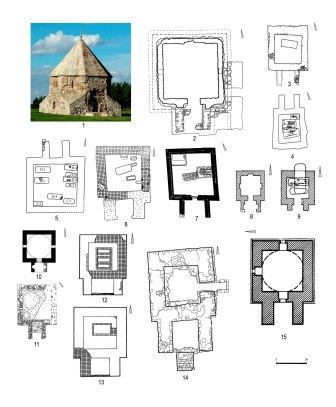Central Asian Parallels in the Memorial Architecture of Mukhshi
DOI:
https://doi.org/10.24852/2587-6112.2022.6.122.132Keywords:
archaeology, Golden Horde, Mukhshi, mausoleums, layout, single-chamber, multi-chamber, portal, Central Asia, khanqah.Abstract
The paper deals with the results of analysis of the layout of the Mokhshi city mausoleums, studied in the late 50s – early 60s of XX century. Five mausoleums have four different layouts. Mausoleum No. 3, which was single-chamber, square in plan with a narrow protruding portal, had the simplest form. This construction has a wide range of analogies both in the Golden Horde and in Central Asia. The rest of the mausoleums belong to the group of multi-chamber buildings. Mausoleum No. 2 consisted of two rooms, it was transverse-axial and also had a portal. In the Golden Horde, buildings of this type are not known, but in Central Asia they are quite common. Mausoleums No. 4 and 5 are elongated along the longitudinal axis and consist of a rectangular lobby and a square in the plan of the sepulcher. This type of layout originated in the Golden Horde. According to the plan, mausoleum No. 1 was the most interesting and complex. It consisted of four rooms and had a T-shaped layout. The construction had a protruding portal and an underground crypt, where burials were made. This building is identical in plan to the mausoleum of Najm al-Din Kubra in Konye-Urgench. The composition and shape of the rooms in these mausoleums make it possible to suppose that they were used not only as memorial buildings, but could serve as a khanqah.
References
Alikhova, A. E. 1973. In Sovetskaia Arkheologiia (Soviet Archaeology) (2), 226–237 (in Russian).
Egorov, V. L. 1980. In Sovetskaia Arkheologiia (Soviet Archaeology) (1), 74–89 (in Russian).
Zilivinskaya, E. D. 2014. Arkhitektura Zolotoi Ordy (Architecture of the Golden Horde) 1. Kul’tovoe zodchestvo (Ritual Architecture). Moscow; Kazan: “Otechestvo” Publ. (in Russian).
Man’kovskaya, L. Yu. 1971. Arkhitekturnye pamyatniki Kashkadar'i (Architectural monuments of Qashqadaryo region). Tashkent: “Uzbekistan” Publ. (in Russian).
Man’kovskaya, L. Yu. 1979. In Gafurov, B. G., Litvinsky, B. A. (eds.). Kul'tura i iskusstvo narodov Sredney Azii v drevnosti i srednevekov'e (Culture and art of the peoples of Central Asia in the antiquity and the Middle Ages). Moscow: “Nauka” Publ., 96–104 (in Russian).
Man’kovskaya, L. Yu. 1983. In Rempel, L. I. (ed.). Khudozhestvennaia kul'tura Sredney Azii IX-XIII vv. (Artistic culture of Central Asia in IX–XIII centuries). Tashkent, 30–49 (in Russian).
Man’kovskaya, L. Yu., Bulatova, L. 1978. Pamiatniki zodchestva Khorezma (Architectural monuments of Khwarazm ). Tashkent (in Russian).
Pugachenkova, G. A. 1958. Puti razvitiia arkhitektury Iuzhnogo Turkmenistana pory rabovladeniia i feodalizma (Ways of Development of South Turkmenistan Architecture during Slavery and Feudalism). Moscow: Academy of Sciences of the USSR (in Russian).
Pugachenkova, G. A. 1967. Iskusstvo Turkmenistana. Ocherk s drevneyshikh vremen do 1917 g. (Art of Turkmenistan. Essay from ancient times till 1917). Moscow: “Iskusstvo” Publ. (in Russian).
Khmel’nitskii, S. 1992. Mezhdu arabami i tiurkami. Arkhitektura Srednei Azii IX–X vv. (Between the Arabs and Turks: Architecture of Central Asia in 9th—10th Centuries). Berlin; Riga: “Continent” Publ. (in Russian).
Khmel’nitskii, S. 1996. Mezhdu Samanidami i mongolami. Arkhitektura Srednei Azii XI – nachala XIII vv. (Between the Samanids and Mongols: Architecture of Central Asia in 11th — Early 13th Centuries). Part I. Berlin; Riga: “Gamajun” Publ. (in Russian).

Downloads
Published
How to Cite
Issue
Section
License
Copyright (c) 2022 E. D. Zilivinskaya

This work is licensed under a Creative Commons Attribution-NonCommercial 4.0 International License.







